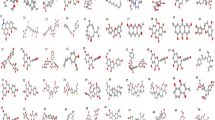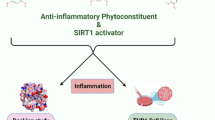Abstract
Breast cancer is a diverse female malignancy; its classification is based on clinical evidence and pathological elucidation. Large public drug screening data databases combined with transcriptome measures have helped develop predictive computational models. Breast cancer is frequent among women worldwide. Several genes increase breast cancer risk. The Mammalian Target of Rapamycin (popularly known as mTOR) is a risk factor mutated in numerous breast carcinoma types. This has caught the scientific community’s focus, which is attempting to generate creative, potent, and bio-available ligands for future anti-cancer treatments to establish a practical therapeutic approach. mTOR is a protein kinase involved in cell proliferation, survival, metabolism, and immune response. Activating mTOR promotes cancer growth and spread. To generate a bioavailable and effective mTOR inhibitor, we used computer-aided drug design to study chromones and flavonoids, two naturally occurring chemicals with many biological activities. We used Curcuma longaderived tiny nano-molecules, which can be coated using liposomes to target mTOR to prevent breast cancer growth. The significant interactions of Curcumin were anticipated using molecular docking. It had the highest binding affinity at -12.26 kcal/mol. 100 nanoseconds of molecular dynamic modelling confirmed Curcumin and mTOR receptor interaction. Liposomes are a form of medicine carrier. To improve healthcare, more liposome-like nanostructures are being made. Nanostructures’ interactions with living creatures are being studied. Half-life, tissue accumulation, and toxicity have been studied. Future medication distribution may use nanocarriers having a liposome-like form, enabling targeted nano-delivery. Curcumin’s interaction with the active site increased the complex’s structural stability during its expansion. Our results may help future investigations of Curcumin’s efficacy as a possible lead treatment targeting mTOR receptors in breast cancer. Using Curcumin as a potential anti-cancer drug with lipid-coated nano-particles allows for tailored administration.
Graphical Abstract








Similar content being viewed by others
Data availability
The datasets used and/or analyzed during the current study are available from the corresponding author upon reasonable request.
References
Aggarwal BB, Harikumar KB (2009) Potential therapeutic effects of curcumin, the anti-inflammatory agent, against neurodegenerative, cardiovascular, pulmonary, metabolic, autoimmune and neoplastic diseases. Int J Biochem Cell Biol 41:40–59
Aggarwal BB, Kumar A, Bharti AC (2003) Anticancer potential of curcumin: preclinical and clinical studies. Anticancer Res 23:363–398
Anand P, Kunnumakkara AB, Newman RA, Aggarwal BB (2007) Bioavailability of curcumin: problems and promises. Mol Pharm 4:807–818
Carty NJ, Foggitt A, Hamilton CR, Royle GT, Taylor I (1995) Patterns of clinical metastasis in breast cancer: an analysis of 100 patients. Eur J Surg Oncol 21(6):607–608
Davies E, Hiscox S (2011) New therapeutic approaches in breast cancer. Maturitas 68(2):121–128
Ferreira LG et al (2015) Molecular docking and structure-based drug design strategies. Molecules 20(7):13384–13421
Gantait S, Debnath S, Ali N (2014) Genomic profile of the plants with pharmaceutical value. 3 Biotech 4(6):563–78
Ghosh A, Mukerjee N, Sharma B, Pant A, Mohanta YK, Jawarkar RD, Bakal RL, Terefe EM, Batiha GE, Mostafa-Hedeab G, Albezrah NK (2021) Target specific inhibition of protein tyrosine kinase in conjunction with cancer and SARS-COV-2 by olive nutraceuticals. Front Pharmacol 2021:12
Grobmyer SR, Zhou G, Gutwein LG, Iwakuma N, Sharma P, Hochwald SN (2012) Nanoparticle delivery for metastatic breast cancer. Nanomedicine 8(Suppl 1):S21–S30
Kalepu S, Nekkanti V (2015) Insoluble drug delivery strategies: review of recent advances and business prospects. Acta Pharm Sin B 5(5):442–453
Kang DI, Kang HK, Gwak HS, Han HK, Lim SJ (2009) Liposome composition is important for retention of liposomal rhodamine in P-glycoprotein-overexpressing cancer cells. Drug Deliv 16(5):261–267
Kreike B, van Kouwenhove M, Horlings H et al (2007) Gene expression profiling and histopathological characterization of triple-negative/basal-like breast carcinomas. Breast Cancer Res 9(5):R65
Maiorov VN, Crippen GM (1994) Significance of root-mean-square deviation in comparing three-dimensional structures of globular proteins. J Mol Biol 235(2):625–634
Miller KD, Siegel RL, Lin CC, Mariotto AB, Kramer JL, Rowland JH, Stein KD, Alteri R (2016) Jemal A (2016) Cancer treatment and survivorship statistics. CA Cancer J Clin 66(4):271–289
Mukerjee N, Das A, Maitra S, Ghosh A, Khan P, Alexiou A, Dey A, Baishya D, Ahmad F, Sachdeva P, Al-Muhanna MK (2022a) Dynamics of natural product Lupenone as a potential fusion inhibitor against the spike complex of novel Semliki Forest Virus. Plos one 25;17(2):e0263853.
Mukerjee N, Maitra S, Roy S, Modak S, Hasan MM, Chakraborty B, Ghosh A, Ghosh A, Kamal MA, Dey A, Ashraf GM (2022b) Treatments against polymorphosal discrepancies in glioblastoma multiforme. Metab Brain Dis 23:1–8
Rasheed, M.A. et al. (2021) Identification of lead compounds against Scm (fms10) in Enterococcus faecium using computer aided drug designing. Life (Basel) 11(2)
Shivakumar D et al (2010) Prediction of absolute solvation free energies using molecular dynamics free energy perturbation and the OPLS force field. J Chem Theory Comput 6(5):1009–1519
Singh AK, Khan IR, Khan S, Pant K, Debnath S, Miah S. Multichannel CNN model for biomedical entity reorganization (2022) Biomed Res. Int 2022
Szulc J, Dudzik M, Woyczikowski B, Sznitowska M, Janicki S (2002) Liposomes – therapeutic progress and technological problems. Pol MerkurLekarski 12(68):164–168
Wang AZ, Langer R, Farokhzad OC (2012) Nanoparticle delivery of cancer drugs. Annu Rev Med 63:185–198
Zhang S, Chu Z, Yin C, Zhang C, Lin G, Li Q (2013) Controllable drug release and simultaneously carrier decomposition of SiO2-drug composite nanoparticles. J Am Chem Soc 135(15):5709–5716
Funding
The author is grateful to the Deanship of Scientific Research at King Khalid University for supporting this study through the Large Research Group Project, under grant number RGP 2/100/43.
Author information
Authors and Affiliations
Contributions
All authors contributed to the study conception and design. Material preparation, data collection, and analysis were performed by Ali H. Alamri, Sandip Debnath, and Arabinda Ghosh. The first draft of the manuscript was written by Taha Alqahtani, Ali Alqahtani, and Saad Ali Alshehri, and all authors commented on previous versions of the manuscript. All authors read and approved the final manuscript.
Corresponding author
Ethics declarations
Ethics approval
Not applicable.
Consent to participate
Not applicable.
Consent for publication
Not applicable.
Conflict of interest
The authors declare no competing interests.
Additional information
Responsible Editor: Lotfi Aleya.
Publisher's note
Springer Nature remains neutral with regard to jurisdictional claims in published maps and institutional affiliations.
Rights and permissions
Springer Nature or its licensor (e.g. a society or other partner) holds exclusive rights to this article under a publishing agreement with the author(s) or other rightsholder(s); author self-archiving of the accepted manuscript version of this article is solely governed by the terms of such publishing agreement and applicable law.
About this article
Cite this article
Alamri, A.H., Debnath, S., Alqahtani, T. et al. Enhancing plant-derived smart nano inhibitor in targeting mammalian target of rapamycin (mTOR) in breast cancer using Curcuma longa-derived compound curcumin. Environ Sci Pollut Res (2023). https://doi.org/10.1007/s11356-023-25375-0
Received:
Accepted:
Published:
DOI: https://doi.org/10.1007/s11356-023-25375-0




